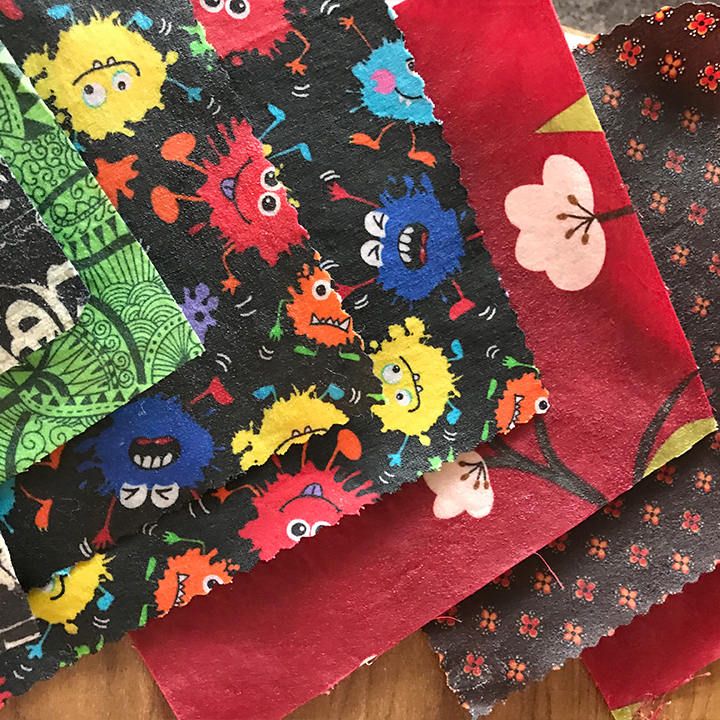By Barb Turner
Collective conversations around how to keep fossil fuels in the ground, textiles out of the landfill, and plastic out of the kitchen have presented at least one simple, awesome praxis: Wax Wraps!

A wax wrap is a wax infused piece of cotton intended to replace plastics in the fridge and packed lunches—taking the place of saran wrap, plastic produce bags, zip lock bags, and waxed paper. Wraps can be used to store cut fruit, sandwiches, fresh produce, or to cover bowls, cups, and casseroles. Fold one into a cup to create a snack pack. These are super useful in lunches. Wax food wraps not only reduce household waste, they are healthy– for us, our environment, and our produce.
There are a variety of recipes out there, but our little collective has settled on a combination of beeswax, pine resin, and jojoba oil infused into 100% cotton. Together these ingredients provide an effective, water-resistant, antimicrobial, antifungal, antioxidant protective-skin for food storage. They are easily washed and easily stored.
Bees wax, pine tar, and jojoba oil all have thousands of years of use medicinally. More recently the properties of each have been specifically quantified in relation to various pathogens. The majority of this research is driven by the pharmaceutical-dermatology and cosmetics industries. It is fitting. The wraps are a skin that both protects and preserves.
Beeswax has been used medicinally for centuries. Its uses are documented in the ancient Greek world as well as Ayurvedic texts. Beeswax shares many of the anti-microbial properties of honey and is resistant to acids. While the protective properties of beeswax are milder than honey, it has been shown to limit the growth of some candida, staphylococcus, and e. coli strains (Frantini, 2016).
Jojoba Oil has been used by the peoples of Northwestern Mexico and Southern Arizona/California for time immemorial. It is used in cosmetic and dermatological industries, and to carry medication. Jojoba receives some serious consideration as a valuable ally in the fight against desertification. It requires very little water. Jojoba oil resists spoilage and its therapeutic properties make it a good option for replacing sperm whale oil. It has powerful antioxidant and anti-fungal properties (Al-Obaidi, 2017). It’s anti-inflammatory and wound healing properties are also long established (Lin, 2018). Don’t skip the jojoba oil! It helps the wrap stay flexible and discourages the wax from cracking and flaking.
Pine Resin/ Pine Tar has been used in medical traditions for over 2000 years. Its antiseptic, antipruritic, anti‐inflammatory, antibacterial, and antifungal properties are well established in the literature. (Barnes, 2017).Pine resin makes the process of creating wraps more difficult, but this ingredient should not be skipped. Not only does it have wonderful protective qualities, it’s the ingredient that makes the wrap stick to itself. Pine tar is finicky with heat, and overheating your wraps or leaving them in the oven for more then a few minutes can evaporate the pitch out of your infusion. Its sticky, so if you aren’t sticking to everything you touch, check your heat and the quality of the solution.
Wax wraps can be made with 100% cotton, upcycled fabrics and last about a year depending on how they are used and cared for. If you don’t know how to test for fiber content of a fabric, look to a fiber burn test chart like this one: http://www.elvesatwork.co.za/the-fabric-burn-test/.
To care for your wraps, wash with a soft cloth or sponge, your regular dish soap, and lightly warm water. Then rinse and either hang to dry, pat dry, or set in the wrack.
As to recipes and ratios, it depends on the size of the batch you want to make. There are plenty of opinions out there, and as long as they have all three ingredients, the proportions are more a matter of preference. We do recommend the double boiler method. The sprinkle method does not produce satisfactory results.. Of course if you’d like to save time and support local environmental activism, you can get the wraps we have made as a part of our perks giveaway in our current crowdfunding campaign. https://fundrazr.com/350Tacoma
But hurry, because time is running out.
Primary Sources:
Al-Obaidi, Halabi, AlKhalifah, Asanar, Al-Soqeer, and Attia. (2017) “A review on plant importance, biotechnological aspects, and cultivation challenges of jojoba plant”. Biol Res. 2017; 50: 25. https://www.ncbi.nlm.nih.gov/pmc/articles/PMC5571488/(accessed 7/21/19).
Lin, Zhong, and Santiago (2018). “Anti-Inflammatory and Skin Barrier Repair Effects of Topical Application of Some Plant Oils” Int J Mol Sci. 2018 Jan; 19(1): 70. https://www.ncbi.nlm.nih.gov/pmc/articles/PMC5796020/(accessed 7/17/19).
Barnes and Greive (2017) Topical pine tar: History, properties and use as a treatment for common skin conditions”. Australas J Dermatol. 2017 May; 58(2): 80–85. https://www.ncbi.nlm.nih.gov/pmc/articles/PMC5434829/(accessed 7/21/19).
Frantini, Cilia, Turchi, & Felicioli (2016) “Beeswax: A minireview of its antimicrobial activity and its application in medicine”. Asian Pacific Journal of Tropical Medicine. Volume 9, Issue 9, September 2016, Pages 839-843. https://www.sciencedirect.com/science/article/pii/S1995764516301407#! (accessed 7/22/19).
Fiber Burn Test, Elves at Workhttp://www.elvesatwork.co.za/the-fabric-burn-test/. (accessed 7/21/19)

